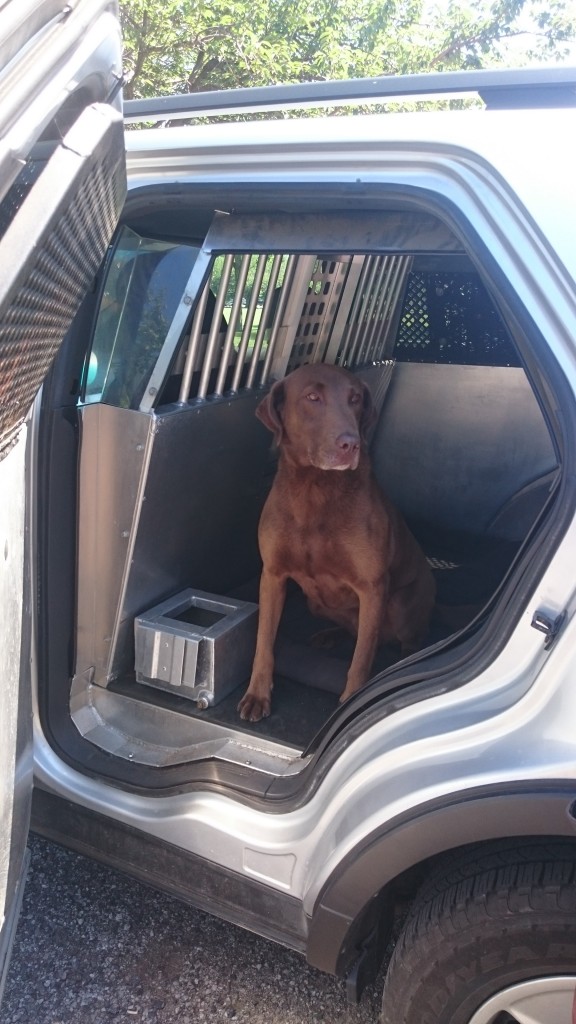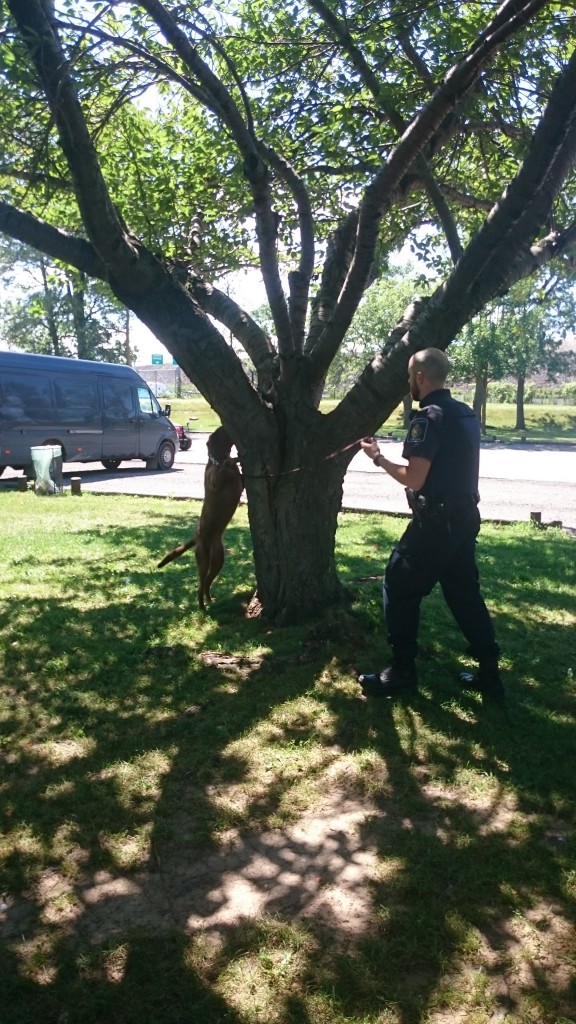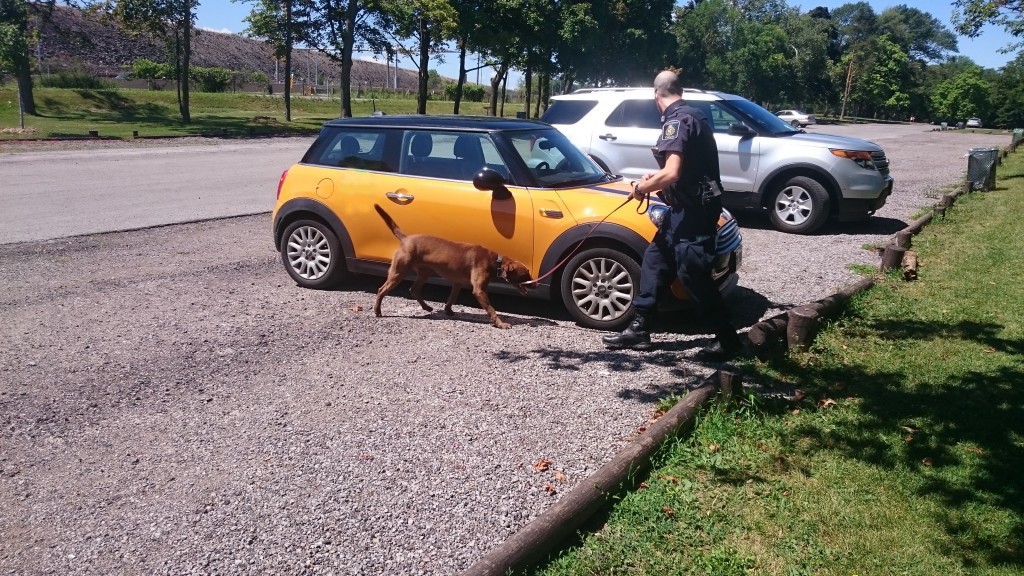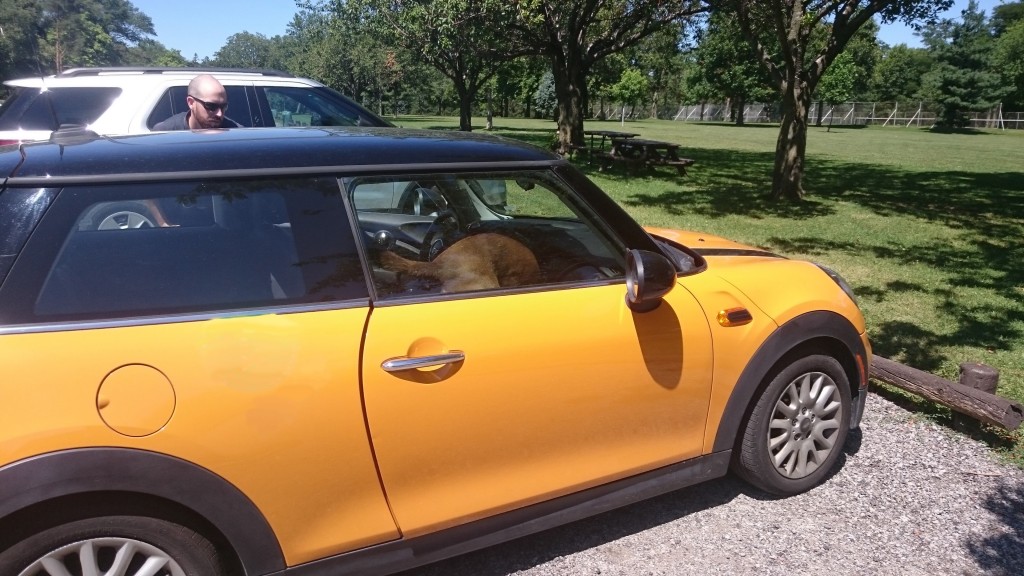This is Sawyer. She’s a five-year-old Chesapeake Bay Retriever.
Looks like a pretty normal, happy-go-lucky dog, right? And she is, sort of. But Sawyer can do something pretty cool that I bet your dog can’t do! And Sawyer has post-secondary education to have learned this nifty trick: she can find by scent drugs or guns. She does this with the help of her partner, Paul Parkinson, Detector Dog Handler, at the Canadian Border Services Agency (CBSA).
You know how they say there’s nothing like a man in a uniform? Now imagine – as I assume most of my readers are dog lovers – a man in a uniform who carries in his belt a gun, ammunition, and a ball to play with his dog. Yep.
Let’s be clear: Sawyer is a partner to Paul, and a tool; a really good one. But she’s also, at least a little bit, a pet. Paul was telling me that they’re supposed to view their dogs as tools rather than as pets, but how could you, in reality? This is an animal who you spend more time with than your own family, who you – and only you – are bonded with, who views their time with you as play time. You’d have to have a heart of stone to be so detached as to view them as just a tool.
Sawyer’s entire life revolves around work. When Paul and I first started talking, we talked about her life outside of work first, and then her work life. To be honest, we probably should have done that in reverse order, because as it was, I was worried about her welfare. Because here’s the thing: Sawyer’s life outside of work is kind of boring. She lives in a kennel outside of Paul’s house (provided by the CBSA), she gets kibble every morning and evening and that’s it, and she isn’t really allowed much affection aside from Paul. He has three kids, and I asked him if that was difficult to enforce, since I’d imagine they love her, and he said that once in a while, every few weeks or months, he’ll let them give Sawyer a hug or belly rub for a minute, but that’s it. Even other CBSA agents can’t give her love and affection or treats. During the nine-and-a-half hour working day (though one-and-a-half hours is maintenance time, so it’s eight hours of actual work time), Sawyer gets to go out and search cars, but in between searches, she’s in the car, just waiting to be allowed out. She can sometimes be in there for an hour or more, just waiting. (Don’t panic! The gas and everything is paid by the CBSA, so she gets to have the AC or heat on, has water, and gets checked on.)

Sounds kind of bleak, right? Especially for a special, chosen dog who got picked as a CBSA dog when only about one in ten1 puppy applicants actually make it?
I thought so too…
…until I saw Sawyer work.
When I first got the idea of interviewing a K9 handler at CBSA, I had to get approved, and explain (in advance) what sort of things I’d be asking about to a communications officer for CBSA. I wrote a lot, but specifically said I wanted to ask about classical conditioning vs operant conditioning, positive reinforcement vs negative reinforcement (or positive punishment, etc.) When I got to talking to Paul, he confessed that, despite him being with the CBSA for over a decade and his almost five years as a dog handler (before which he spend several months in school specifically learning to be a dog handler), he didn’t know what most of those things were, but they used mostly positive reinforcement. Dog trainer jargon!
I was thrilled to see that they really do use positive reinforcement. I wasn’t sure going into it, as I’d imagined police officer, drug dogs, and so forth, being a more old-fashioned field. Two seconds of watching Sawyer work shot that misconception out the window. She was raring to go; tongue lolling, tail wagging, a very happy puppy.
To start with, Paul and I went to the trunk of his SUV. He pulled on gloves, so that the drugs (which he had access to as training samples, of course) we hid for Sawyer wouldn’t get his scent on it. I didn’t take a picture of his trunk, but it was so funny – dog toys, and then little metal lock boxes with every drug imaginable in – little mason jars of ecstasy, hash, heroin, marijuana, cocaine… probably more that I don’t even know. Paul pulled out some hash oil, and we hid it in a tree. Then, he leashed up Sawyer, and they were off!
Paul ran backwards, and Sawyer zoomed along toward him. He’d give her cues like “search up” and she’d jump on the picnic table and sniff around, or “search down” and she’d sniff underneath (we were pretending the picnic table was a car).
Finally, she zoomed toward the tree and jumped up and found the oil. Instead of barking or scratching, like police dogs do (or like you see in the movies), she sat. This is what’s called a passive indication versus an active indication.
So, she sits down, practically vibrating with excitement, and – this is where the positive reinforcement comes in – Paul yells, “YAHOO!” and throws the ball from his belt, and she bolts after it.
Oh, I realized, This is a game to her. She loves this!
Next, we hid the hash oil in my car, under the passenger seat. This was at my request; I was delighted by watching her work. She is GOOD. She circled the car once, and basically seemed to already know where it was. To make it trickier, Paul let her in the car through the drivers side instead of the passenger side, but within seconds, she was in the back seat, sitting behind the passenger seat, tail wagging. “YAHOO!”, and a game of fetch for her!
Life is pretty good for Miss Sawyer. Her day job is a game, and she has a great partner who loves her. So what happens when she can’t work anymore?
CBSA dogs retire no later than at the age of eleven, earlier if needed. First choice, of course, goes to their handler. If they don’t want to keep their partner as a pet, CBSA finds the dog another home – none get put down, none end up in shelters. Apparently the transition from working dog to pet can be tough on the pups – lots of changes, not least of which being that their handler begins going off to AWESOME FUN PLAY TIME FINDING DRUGS (read: work, in human speak) without them – and maybe even with another dog.
I asked Paul if he plans to keep Sawyer once she’s retired. “Yes,” he said, no hesitation at all. “Of course. I don’t want my time as her handler to end, but when it does, after her last shift, we are going to McDonalds, getting her a cheeseburger, and living happily ever after.”





Wow Sawyer is one lucky pup to be able to”play” all the time with someone who loves her as much as she love him,xx Speedy
Great story. I believe dog’s love to have a job and purpose. It’s such a great use for his skills and motivation to please. When dog’s are bored and have no where to use their energy is when dog’s get frustrated with life. What a great life for Sawyer. Cheers from http://www.meowlifestyle.com :-)